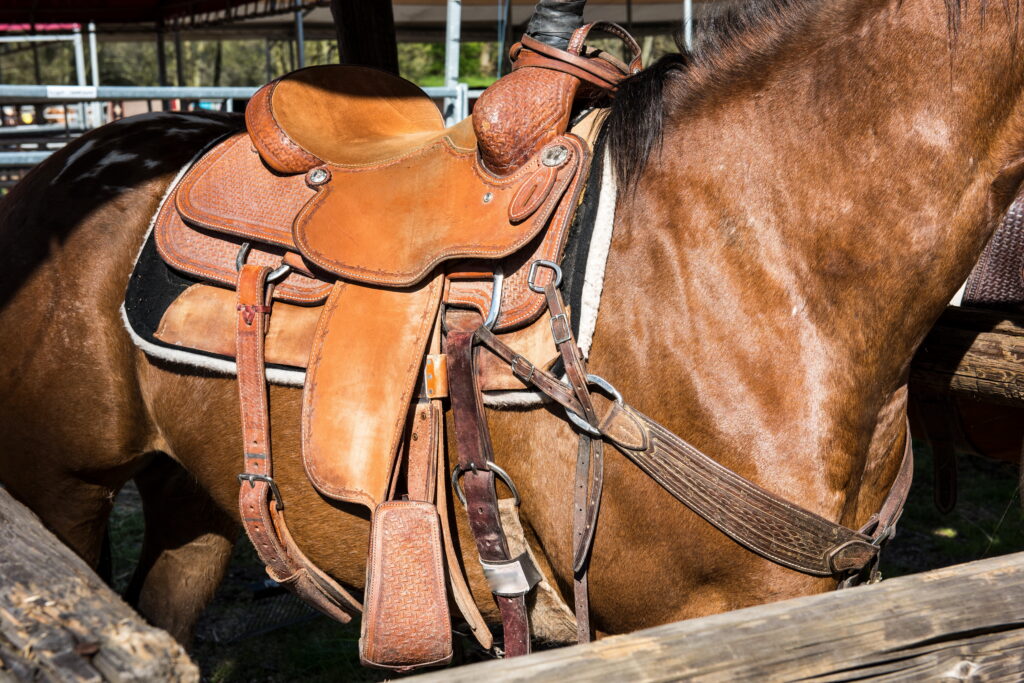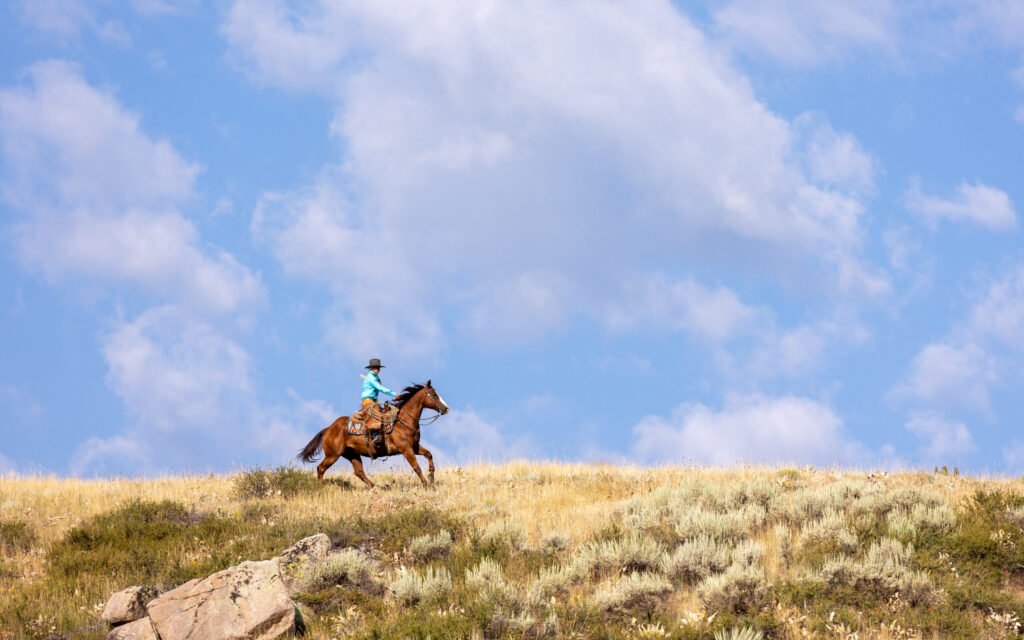As the sun lingers a little longer and the scent of spring fills the air, it’s the perfect time to start thinking about your favorite time of year: summer trail riding. Before you load up your horse and head for the hills, there are a few things you should tackle to ensure your adventure goes off without a hitch. From checking your rig to inspecting your tack, conditioning your trail horse, and planning your route, a little preparation now can save you from headaches down the trail.
Let’s first focus on the steps you can take to prepare yourself, your gear, and your rig. Then we’ll delve into the expert advice from renowned clinician and horsewoman, Stacy Westfall, on preparing your horse for summer trips.
Give Your Rig a Thorough Once-Over Before Hitting the Trail
Your trailer may have been sitting idle during the colder months. Even if it’s been in use, don’t forget routine maintenance checks. Start with the basics. Inspect your tires for wear and tear, checking for cracks or low pressure. Trailer tires often age even when not in use. Be sure to examine your spare tire as well and ensure you have the necessary equipment to change a blown tire on the road.

Prepare your rig now. Make sure you have time for general maintenance requirements before you hit the road in a couple of months.
Henryk Sadura/adobe.stock.com
Take a close look at the lights and electrical components. Have a friend help you confirm that your brake lights, turn signals, and running lights are all functioning properly. Test your trailer braking system and ensure it’s responsive. Take a short drive down the road with an empty trailer to test your trailer brakes. Don’t forget to inspect your hitch, collar, and safety chains for any signs of rust or damage.
Inside the trailer, check for loose or sharp edges that could harm your horse. Clean out any leftover bedding, rinse the mats, and inspect the floorboards carefully. Proper ventilation is vital, so check the vents and windows, ensuring they open and close smoothly. In warmer climates where bees and hornets are active, inspect your trailer for signs of nests. Completing these safety checks now can prevent major issues later on.
Assess Your Gear
Whether your tack is brand new or has seen its fair share of rides, wear and tear can sneak up on you. Lay out your saddle, bridle, and all other gear, then inspect every inch. Look for cracked leather, frayed stitching, and worn-out buckles. Tighten Chicago screws, examine your cinch, back cinch, and latigo, and ensure there are no weak spots in your gear. Make it a habit to check your gear before every ride.
Give your saddle pad a thorough inspection as well. Wash and dry it thoroughly to remove sweat, dirt, and hair. A clean pad not only keeps your horse comfortable but also prevents irritation and sores. Follow the cleaning instructions for the material you use; wool requires different care than neoprene. Since summer trail riding can make your horse sweat quickly, make cleaning your pad a regular practice.

Don’t forget to check your own trail riding gear. Inspect your boots, helmet, and other essentials for any damage. Keeping your gear clean and well-maintained is crucial for your safety and your horse’s safety.
Plan Your Summer Trail Riding Adventure
Now that your rig and gear are in order, it’s time to start planning your route for summer trail rides. This is a great task for those stuck indoors during a Spring snowstorm. Research local trails or consider exploring a new location this summer. Check trail conditions, seasonal restrictions, and any permits you might need. National and state parks often have specific regulations for horseback riding, so be sure to check beforehand.
Consider the length and difficulty of the trails, as well as water sources and camping spots if you’re going on overnight trips. Knowing the terrain will help you determine if your horse can handle these trails. Download or print maps of the trails and familiarize yourself with landmarks to navigate confidently.
It’s also wise to check the weather forecast for your planned riding days. Summer storms can arrive unexpectedly, so having a backup plan is always a good idea. While this tip applies to the days before your ride, if you’re riding in new territory, familiarize yourself with typical weather patterns for the time of year you’ll be riding. Some areas experience snow well into the warmer months.
Preparing Your Horse for Summer Trail Riding Adventures
Stacy Westfall guides us through her springtime routine to condition her trail horse and prepare him for the new sights and sounds he’ll encounter on the trail.

Gearing Up After Winter Down Time
If you live in a cold-weather area, you may have given your horse the winter off to rest and recharge. When bringing your trail horse back into work, be prepared for extra energy and a fresh horse ready to go. However, remember that excess energy can sometimes lead to issues.
“If your horse feels ‘up’ when riding outside again, consider whether your reactions are building trust or unintentionally confirming their concerns,” Westfall advises, recalling a recent situation where a ‘fresh’ horse was receiving mixed signals from the rider. “I was coaching a student who mentioned her horse was ‘up’ when she rode outside in the driveway for the first time this spring, and again when she opened the end door on the indoor arena.
“We discussed the rider’s default response and whether it was helping build future confidence or creating more uncertainty.” In this case, the horse had been ridden in both situations before, and the rider could identify where she was backing off instead of supporting the horse in her own body. Once the rider focused on supporting with her aids, the horse’s focus returned to the rider.
Use Everyday Spaces for Reintroducing Trail Skills
Since you spend most of your time at home rather than on the trail, prepare your horse for trail-riding challenges in the comfort and safety of your own environment. Whether your horse is a seasoned trail veteran or new to the experience, you can utilize your surroundings to give him a change of scenery.
“I think people often overlook what can be achieved by simply riding in the driveway or, if conditions permit, in the pasture,” Westfall noted. “My horses are often excited by the change of scenery and the spring weather, so even though they have been ridden over the winter, they still experience a change.”
Westfall stressed the importance of using your property to ready your horse for the trail. “For this reason, I ride indoors first and then, weather permitting, I move out to the driveway. Many barns have paths leading to pastures or paddocks, or parking lots large enough to maneuver trucks and trailers, providing space to ride.”
Make use of what you have at home to introduce your horse to new sights after his winter break, and be prepared for his reaction to unfamiliar surroundings!
Making the Transition from Riding Indoors to Outdoors
Even the most seasoned horses can take notice when the scenery changes. For this reason, Westfall recommends gradually transitioning to outdoor riding to boost your horse’s confidence as you progress.
“Starting outside in controlled areas before hitting the trails helps ease the transition,” Westfall advises, sharing her typical riding routine when moving from indoors to outdoors. “I begin by riding the initial part of my ride indoors first, then transition to the driveway. Even this small change can elicit extra energy in my horses.”
When introducing new surroundings to your horse, even on your own property, assess how he reacts. It’s better to prepare at home for your horse’s response to new stimuli than to encounter surprises five miles down the trail.
Transition to outside riding gradually, giving your horse time to build confidence.
Photo courtesy of Stacy Westfall.

“Notice whether your horse simply acknowledges distractions or completely loses focus. Small adjustments now can prevent bigger issues on the trail,” Westfall advises. With three new trail partners in her string this year, she’s taking the time to understand their behaviors when riding outside.
“When I go outside with any of them, I’m observing what stays the same as in the indoor arena and what changes. These include how they respond to my rein cues, how often their focus shifts away from me to something else, and how ‘completely’ their focus shifts. Do they notice chipmunks but remain aware of me, meaning they haven’t truly lost focus, or do they see something in the distance and ignore cues? For example, if they stiffen, resist bending, or require stronger cues, I anticipate up to a 10% change. Anything beyond that raises a red flag,” she explains.
Conditioning Your Horse at Home
When conditioning your trail horse after a winter break, gradually build up his fitness to reduce the risk of injury or burnout. Take this time to prepare your horse physically so you can tackle any terrain you encounter on the trails with confidence.
READ: Stacy Westfall’s Tips to Get Your Horse Fit for the Adventure
“In the spring, when I’m boosting my horse’s fitness for trails, my arena rides are as long as or longer than my trail rides, and more intense,” Westfall shares. She tailors her at-home conditioning program to align with her trail riding plans. “For instance, if my first trail ride will be 30 minutes – 15 out and 15 back – I aim to ride longer than that in the arena, including at a trot and lope.”
“If trails aren’t accessible yet, start conditioning on hills or open areas nearby. A few minutes of hill work early in the season helps build strength before longer rides,” Westfall advises, emphasizing the importance of gradually building your horse’s stamina over time. “I have some hills behind my barn that I start riding up and down as soon as conditions allow. This helps with both strength-building and mental adjustment before I take my horses on the trails, where hills will be part of the ride.”
An Ounce of Prevention…
Spending some time on maintenance, gear checks, and thoughtful planning will ensure you and your horse are ready to hit the trails safely and comfortably. When the sun rises on your first big adventure of the season, you’ll be thankful you took these steps. Keep your rig in good condition, check your gear, and prepare your horse both physically and mentally

